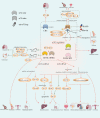N7-methylguanosine modification: from regulatory roles to therapeutic implications in cancer
- PMID: 37293166
- PMCID: PMC10244098
N7-methylguanosine modification: from regulatory roles to therapeutic implications in cancer
Abstract
N7-methylguanosine (m7G) is one of the most common post-transcriptional epigenetic modifications. Different m7G methyltransferases (writers) load the m7G-cap at the 5'-terminal or inside the RNAs. For example, writers such as methyltransferase-like 1 (METTL1)/WD repeat domain 4 (WDR4) and Williams-Beuren syndrome chromosome region 22 (WBSCR22) have been reported in mammals to promote cell proliferation, EMT, and chemoresistance in massive quantities of cancers. The underlying mechanism includes modulating the RNA secondary structure, preventing RNA degradation from exonucleases, and improving codon-dependent translation. However, some studies have shown that in colorectal and lung cancers, m7G inhibits tumor progression. m7G binding proteins (readers), such as eukaryotic translation initiation factor 4E (eIF4E), promote the efficiency of cap-dependent translation and accelerate the cell cycle to improve cancer progression. Due to the more profound understanding of m7G regulatory proteins in cancer, numerous studies aim to investigate the clinical efficiency of m7G-targeted therapy. eIF4E antisense oligonucleotide drug (4EASO) and Ribavirin are the most mature trials that competitively inhibit the binding of eIF4E to m7G-cap. These drugs have encouraging results in halting cancer progression and improving prognosis, including AML and non-small cell lung cancer, which provide a promising perspective for developing more m7G-targeted drugs. In the future, we look forward to an ongoing investigation into the role of m7G modification in tumors and drug resistance to m7G-related therapies to be solved. Therefore, the clinical application would be put into practice as soon as possible.
Keywords: N7-methylguanosine modification; RNA metabolism; cancer; cancer therapy.
AJCR Copyright © 2023.
Conflict of interest statement
None.
Figures



Similar articles
-
m7GRegpred: substrate prediction of N7-methylguanosine (m7G) writers and readers based on sequencing features.Front Genet. 2024 Aug 28;15:1469011. doi: 10.3389/fgene.2024.1469011. eCollection 2024. Front Genet. 2024. PMID: 39262420 Free PMC article.
-
METTL1/WDR4-mediated m7G Hypermethylation of SCLT1 mRNA Promotes Gefitinib Resistance in NSCLC.Genomics Proteomics Bioinformatics. 2025 Aug 26:qzaf076. doi: 10.1093/gpbjnl/qzaf076. Online ahead of print. Genomics Proteomics Bioinformatics. 2025. PMID: 40857569
-
Methyltransferase 1-mediated tRNA N7-methylguanosine modification regulates dentin formation during tooth root development via p53 signaling.J Bone Miner Res. 2025 Jun 3;40(6):813-823. doi: 10.1093/jbmr/zjaf056. J Bone Miner Res. 2025. PMID: 40247703
-
Functions of METTL1/WDR4 and QKI as m7G modification - related enzymes in digestive diseases.Front Pharmacol. 2025 Jan 9;15:1491763. doi: 10.3389/fphar.2024.1491763. eCollection 2024. Front Pharmacol. 2025. PMID: 39850560 Free PMC article. Review.
-
Deciphering the secret codes in N7-methylguanosine modification: Context-dependent function of methyltransferase-like 1 in human diseases.Clin Transl Med. 2025 Feb;15(2):e70240. doi: 10.1002/ctm2.70240. Clin Transl Med. 2025. PMID: 39979979 Free PMC article. Review.
Cited by
-
The role of RNA modifications in hepatocellular carcinoma: functional mechanism and potential applications.Front Immunol. 2024 Aug 20;15:1439485. doi: 10.3389/fimmu.2024.1439485. eCollection 2024. Front Immunol. 2024. PMID: 39229278 Free PMC article. Review.
-
RNA modification: a promising code to unravel the puzzle of autoimmune diseases and CD4+ T cell differentiation.Front Immunol. 2025 Mar 24;16:1563150. doi: 10.3389/fimmu.2025.1563150. eCollection 2025. Front Immunol. 2025. PMID: 40196109 Free PMC article. Review.
-
METTL1-mediated m7G modification promotes colorectal cancer metastasis via stabilization of ICAM-1.Mol Cell Biochem. 2025 Aug;480(8):4769-4780. doi: 10.1007/s11010-025-05293-0. Epub 2025 Apr 19. Mol Cell Biochem. 2025. PMID: 40252158
-
N7-methylguanosine modification in cancers: from mechanisms to therapeutic potential.J Hematol Oncol. 2025 Jan 29;18(1):12. doi: 10.1186/s13045-025-01665-7. J Hematol Oncol. 2025. PMID: 39881381 Free PMC article. Review.
-
Regulations of m6A and other RNA modifications and their roles in cancer.Front Med. 2024 Aug;18(4):622-648. doi: 10.1007/s11684-024-1064-8. Epub 2024 Jun 22. Front Med. 2024. PMID: 38907157 Review.
References
Publication types
LinkOut - more resources
Full Text Sources
Miscellaneous
